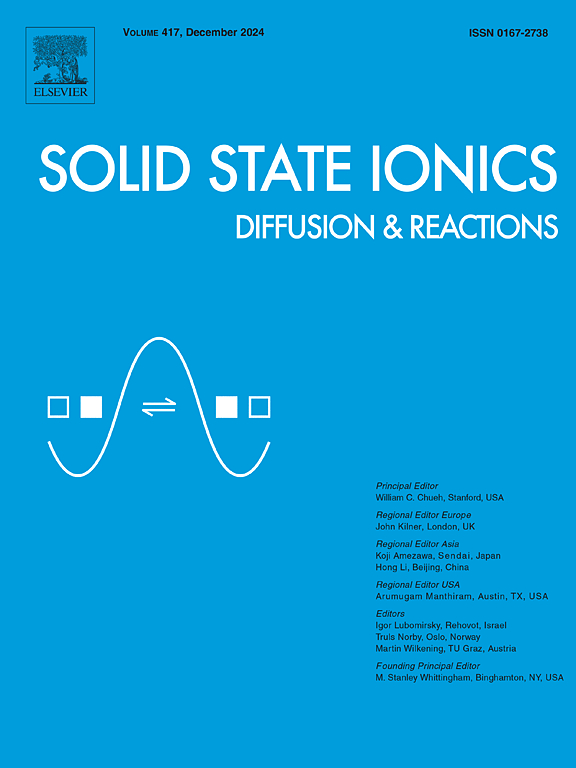Electrophoretically deposited polymer-in-ceramic electrolyte comprising polymerized ionic liquid
IF 3.3
4区 材料科学
Q3 CHEMISTRY, PHYSICAL
引用次数: 0
Abstract
Composite solid electrolytes, in which superionic ceramics materials are combined with ion-conducting polymers, could revolutionize electrochemical-energy-storage devices enabling higher energy density, providing greater stability during operation and enhanced safety. However, the interfacial resistance between the ceramic and polymer phases strongly suppresses the ionic conductivity and presents the main obstacle for the practical uses.
In the current article, an attempt has been made to improve composite conductivity by significantly increasing ceramic concentration in combination with the polymerized ionic liquid (PolyIL). The film was prepared by the electrophoretic deposition method. We believe this is the first demonstration of a PolyIL as a multifunctional additive in EPD, enabling both field-driven deposition and an integrated electrolyte architecture that ensures mechanical cohesion and continuous ion transport pathways. We deposited thirty-micron-thick composite film, which contains more than 90 wt% of LAGP. It has porous structure, in which single ceramic particles and their aggregates are coated by PolyIL. Broad Band Dielectric Spectroscopy method is used for the understanding of ion transport in composite polymer-in-ceramic electrolyte. We observed no improvement in conductivity and assign this to the dominating effect of interfacial energy barriers limiting Li transport in composites.
电泳沉积的聚合物陶瓷电解质,包括聚合离子液体
复合固体电解质,其中超离子陶瓷材料与离子导电聚合物相结合,可以彻底改变电化学能量存储设备,实现更高的能量密度,在操作过程中提供更大的稳定性和增强的安全性。然而,陶瓷相和聚合物相之间的界面电阻强烈地抑制了离子电导率,是实际应用的主要障碍。在这篇文章中,我们尝试通过显著提高陶瓷浓度与聚合离子液体(PolyIL)的结合来提高复合材料的导电性。采用电泳沉积法制备薄膜。我们相信这是PolyIL在EPD中作为多功能添加剂的第一次演示,既可以实现场驱动沉积,也可以实现集成电解质结构,确保机械凝聚力和连续的离子传输途径。我们沉积了30微米厚的复合薄膜,其中含有超过90%的LAGP。它具有多孔结构,其中单个陶瓷颗粒及其聚集体被聚乙二醇包裹。采用宽频带介电光谱方法研究了复合聚合物陶瓷电解质中的离子输运。我们没有观察到电导率的改善,并将其归因于限制复合材料中Li输运的界面能垒的主导作用。
本文章由计算机程序翻译,如有差异,请以英文原文为准。
求助全文
约1分钟内获得全文
求助全文
来源期刊

Solid State Ionics
物理-物理:凝聚态物理
CiteScore
6.10
自引率
3.10%
发文量
152
审稿时长
58 days
期刊介绍:
This interdisciplinary journal is devoted to the physics, chemistry and materials science of diffusion, mass transport, and reactivity of solids. The major part of each issue is devoted to articles on:
(i) physics and chemistry of defects in solids;
(ii) reactions in and on solids, e.g. intercalation, corrosion, oxidation, sintering;
(iii) ion transport measurements, mechanisms and theory;
(iv) solid state electrochemistry;
(v) ionically-electronically mixed conducting solids.
Related technological applications are also included, provided their characteristics are interpreted in terms of the basic solid state properties.
Review papers and relevant symposium proceedings are welcome.
 求助内容:
求助内容: 应助结果提醒方式:
应助结果提醒方式:


